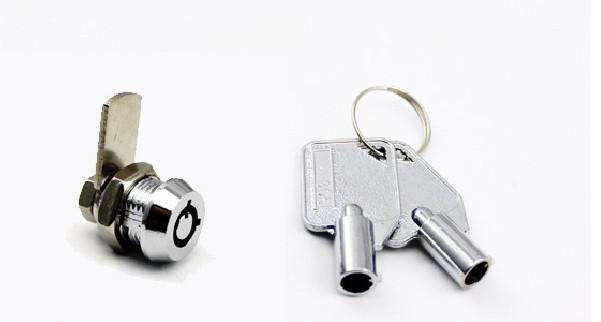Cam lock has wide application. Based on structure, cam lock is classified into plum blossom pin tumbler lock, blade cam lock and triangle cam lock.
1. Plum blossom pin tumbler lock
Plum blossom pin tumbler lock refers to that lock pins controlling lock to rotate are copper billiards, having small dimensions. At present, plum blossom pin tumbler lock is one of the mostly used locks. One type is that has smaller dimensions. This type of locks is a kind of locks matching with 300 categories of key. The other type of locks is that has larger dimensions and seven billiards. The type of locks can match with nearly ten thousands of keys, having excellent security. Zinc alloy and copper are used as raw materials for plum blossom pin tumbler lock.
2. Blade cam lock
Blade block is that the lock pins which control lock to turn inside structure are metal blade (usually made of copper and stainless). This type of cam lock has simple structure, easy for being processed. Blade cam lock is usually used for mailbox, filing cabinet and tool cabinet. Categories of secret keys range from dozens of categories to 200 categories. Zinc alloy is used as raw material for blade cam lock.
3. Triangle cam lock
Key cylinder of triangle cam lock is solid triangle, linear and square. Their keys can be shared. Triangle cam lock is widely applied in industrial equipment. The raw material is mainly zinc alloy. Only a few triangle cam locks adopts stainless steel.
In addition, when people choose lock, people are commonly worried about that lock has poor durability or the surface of lock is rust and oxidized, only being used for a short period. The issue has closed relationship with the used materials and their surface treatment. In terms of durability, the best material is stainless steel. Especially, the materials which are used for the surface of cam lock, the commonly are used, the brighter surface is. Stainless steel has good strength, strong corrosion resistance and color does not change. Stainless steel also has different categories, mainly classified into ferrite and austenite. Ferrite stainless steel also called as rustless iron, has magnetic property. Rustless iron also can be rust if it is used for a long time or under bad environment. Only austenite stainless steel cannot be rust. Identification is quite simple, just only using a magnet.
Copper is one of the materials which are the most commonly used for lock, having good mechanical properties, strong corrosion resistance and processability. Copper has gorgeous colors. In particular, handle and other lock decorative parts which are forged by using copper, have flat surface, good density without pore and sand holes. Copper also has fastness and rust protection. The surface can be plated with 24K gold or gulch golf for surface treatment, showing gorgeousness and nobleness, adding colors to people's home furnishing.
Zinc alloy cam lock has poorer strength and rust protection. However, the advantage of zinc alloy is that it can be made into parts having complicated pattern, especially by using die casting. Locks having complicated patterns which are commonly seen on market are possibly made from zinc alloy. Consumers should distinguish locks carefully. Steel has higher strength and lower cost while it is rust easily. In generally, steel is used as material for internal structure of cam lock. It is not suitable for external decorative parts.

1. Plum blossom pin tumbler lock
Plum blossom pin tumbler lock refers to that lock pins controlling lock to rotate are copper billiards, having small dimensions. At present, plum blossom pin tumbler lock is one of the mostly used locks. One type is that has smaller dimensions. This type of locks is a kind of locks matching with 300 categories of key. The other type of locks is that has larger dimensions and seven billiards. The type of locks can match with nearly ten thousands of keys, having excellent security. Zinc alloy and copper are used as raw materials for plum blossom pin tumbler lock.
2. Blade cam lock
Blade block is that the lock pins which control lock to turn inside structure are metal blade (usually made of copper and stainless). This type of cam lock has simple structure, easy for being processed. Blade cam lock is usually used for mailbox, filing cabinet and tool cabinet. Categories of secret keys range from dozens of categories to 200 categories. Zinc alloy is used as raw material for blade cam lock.
3. Triangle cam lock
Key cylinder of triangle cam lock is solid triangle, linear and square. Their keys can be shared. Triangle cam lock is widely applied in industrial equipment. The raw material is mainly zinc alloy. Only a few triangle cam locks adopts stainless steel.
In addition, when people choose lock, people are commonly worried about that lock has poor durability or the surface of lock is rust and oxidized, only being used for a short period. The issue has closed relationship with the used materials and their surface treatment. In terms of durability, the best material is stainless steel. Especially, the materials which are used for the surface of cam lock, the commonly are used, the brighter surface is. Stainless steel has good strength, strong corrosion resistance and color does not change. Stainless steel also has different categories, mainly classified into ferrite and austenite. Ferrite stainless steel also called as rustless iron, has magnetic property. Rustless iron also can be rust if it is used for a long time or under bad environment. Only austenite stainless steel cannot be rust. Identification is quite simple, just only using a magnet.
Copper is one of the materials which are the most commonly used for lock, having good mechanical properties, strong corrosion resistance and processability. Copper has gorgeous colors. In particular, handle and other lock decorative parts which are forged by using copper, have flat surface, good density without pore and sand holes. Copper also has fastness and rust protection. The surface can be plated with 24K gold or gulch golf for surface treatment, showing gorgeousness and nobleness, adding colors to people's home furnishing.
Zinc alloy cam lock has poorer strength and rust protection. However, the advantage of zinc alloy is that it can be made into parts having complicated pattern, especially by using die casting. Locks having complicated patterns which are commonly seen on market are possibly made from zinc alloy. Consumers should distinguish locks carefully. Steel has higher strength and lower cost while it is rust easily. In generally, steel is used as material for internal structure of cam lock. It is not suitable for external decorative parts.


